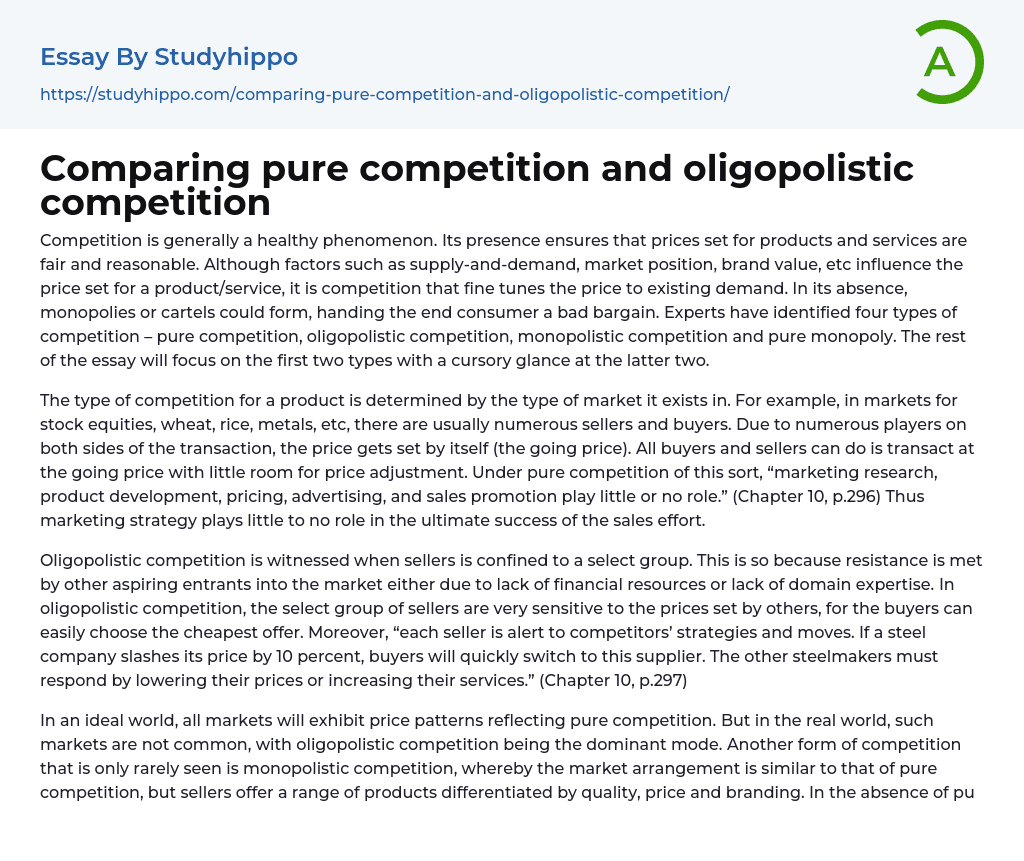

Comparing pure competition and oligopolistic competition Essay Example
Competition is generally a healthy phenomenon. Its presence ensures that prices set for products and services are fair and reasonable. Although factors such as supply-and-demand, market position, brand value, etc influence the price set for a product/service, it is competition that fine tunes the price to existing demand. In its absence, monopolies or cartels could form, handing the end consumer a bad bargain. Experts have identified four types of competition – pure competition, oligopolistic competition, monopolistic competition and pure monopoly. The rest of the essay will focus on the first two types with a cursory glance at the latter two.
The type of competition for a product is determined by the type of market it exists in. For example, in markets for stock equities, wheat, rice, metals, etc, there are usual
...ly numerous sellers and buyers. Due to numerous players on both sides of the transaction, the price gets set by itself (the going price). All buyers and sellers can do is transact at the going price with little room for price adjustment. Under pure competition of this sort, “marketing research, product development, pricing, advertising, and sales promotion play little or no role.” (Chapter 10, p.296) Thus marketing strategy plays little to no role in the ultimate success of the sales effort.
Oligopolistic competition is witnessed when sellers is confined to a select group. This is so because resistance is met by other aspiring entrants into the market either due to lack of financial resources or lack of domain expertise. In oligopolistic competition, the select group of sellers are very sensitive to the prices set
by others, for the buyers can easily choose the cheapest offer. Moreover, “each seller is alert to competitors’ strategies and moves. If a steel company slashes its price by 10 percent, buyers will quickly switch to this supplier. The other steelmakers must respond by lowering their prices or increasing their services.” (Chapter 10, p.297)
In an ideal world, all markets will exhibit price patterns reflecting pure competition. But in the real world, such markets are not common, with oligopolistic competition being the dominant mode. Another form of competition that is only rarely seen is monopolistic competition, whereby the market arrangement is similar to that of pure competition, but sellers offer a range of products differentiated by quality, price and branding. In the absence of pure competition, both monopolistic competition and oligopolistic competition are partially likely to reflect consumer interest as opposed to business interest.
Finally, we have the pure monopoly market, where price is largely decoupled from external factors and is largely a reflection of management policies. Usually, the word monopoly is much dreaded by the end consumer but is most desired by a business enterprise. But its effects are far more complex than this simple view. Take say, the U.S. Postal Service. Although assuming a monopoly position in its market, being a not-for-profit enterprise, it serves the interests of the general population. But if a pure monopoly were to be established in the business domain, consumers will have little control over the quality or price of the commodity and are likely to be exploited.
Works Cited:
Chapter 10, Pricing Products: Understanding and Capturing
Customer Value, Designing a Customer-Driven Marketing Strategy and Integrated Marketing Mix, p.294-298.
Goodwin, N, Nelson, J; Ackerman, F & Weissskopf, T: Microeconomics in Context 2d ed. Sharpe 2009
Competition is generally a healthy phenomenon. Its presence ensures that prices set for products and services are fair and reasonable. Although factors such as supply-and-demand, market position, brand value, etc influence the price set for a product/service, it is competition that fine tunes the price to existing demand. In its absence, monopolies or cartels could form, handing the end consumer a bad bargain. Experts have identified four types of competition – pure competition, oligopolistic competition, monopolistic competition and pure monopoly. The rest of the essay will focus on the first two types with a cursory glance at the latter two.
The type of competition for a product is determined by the type of market it exists in. For example, in markets for stock equities, wheat, rice, metals, etc, there are usually numerous sellers and buyers. Due to numerous players on both sides of the transaction, the price gets set by itself (the going price). All .
- Business Analysis essays
- Business Plan essays
- Community Development essays
- Competition essays
- Effective Leadership essays
- Leadership Styles essays
- Mission Statement essays
- Negotiation essays
- Outsourcing essays
- Planning essays
- Public relations essays
- Reasoning essays
- Strategic Management essays
- Strategic Planning essays
- Swot Analysis essays
- American Dream essays
- Barriers To Entry essays
- Capitalism essays
- Central Bank essays
- Compensation essays
- Consumerism essays
- Economic Development essays
- Economic Growth essays
- Economic Inequality essays
- Economic System essays
- Economy essays
- Employment essays
- Export essays
- Finance essays
- Free Trade essays
- Gross Domestic Product essays
- Human Development essays
- Income Inequality essays
- Industry essays
- Inflation essays
- International Business essays
- International Trade essays
- Macroeconomics essays
- Materialism essays
- Max Weber essays
- Microeconomics essays
- Minimum Wage essays
- Monetary Policy essays
- Monopoly essays
- Pricing essays
- Profit essays
- Recession essays
- resources essays
- Taxation essays
- Trade essays



